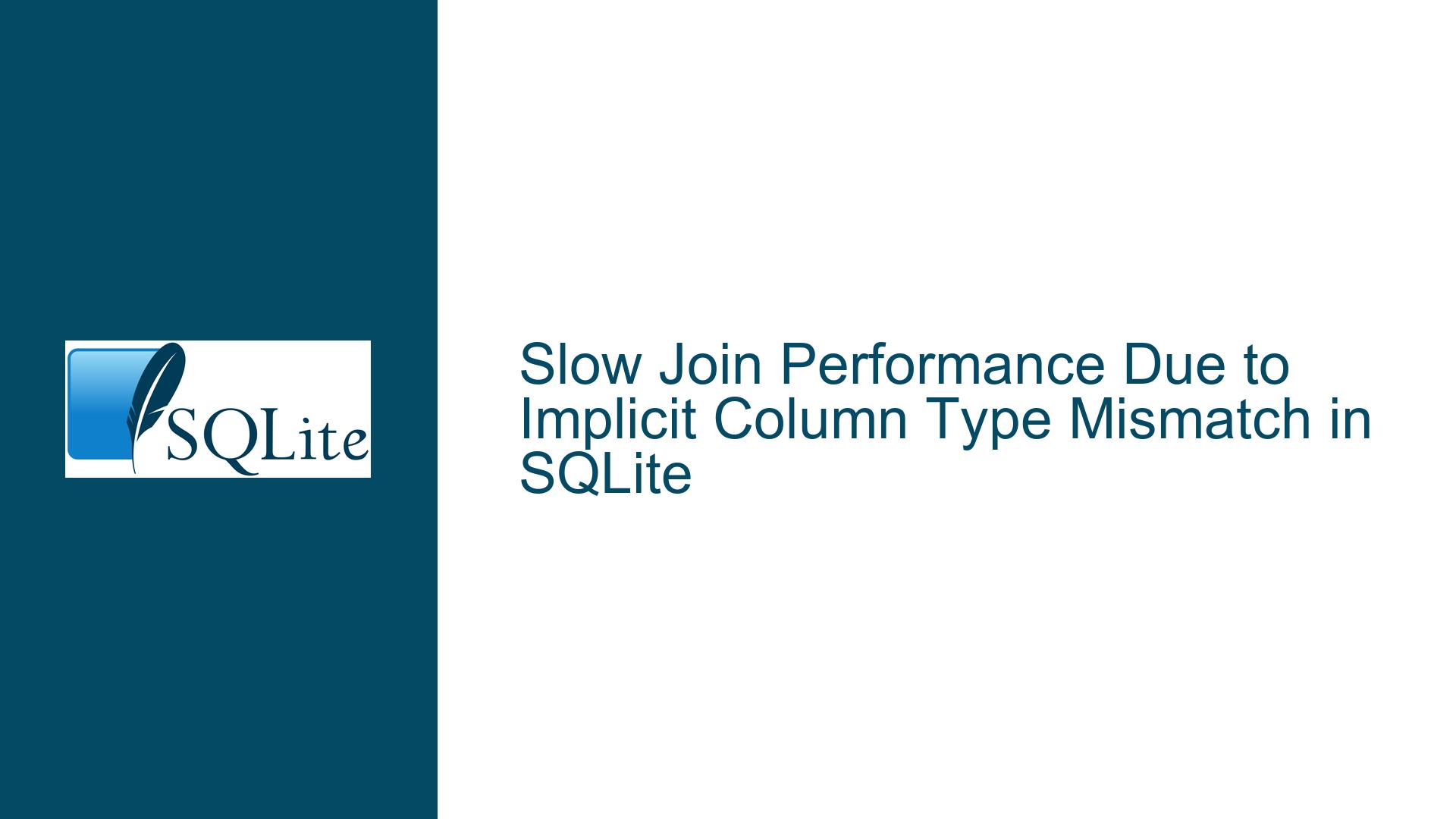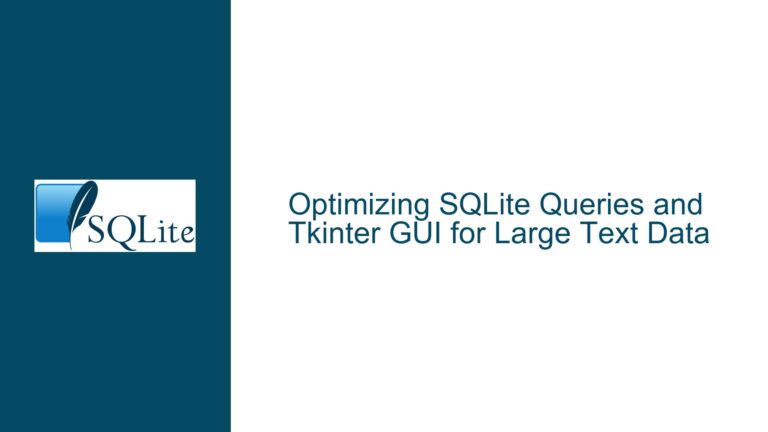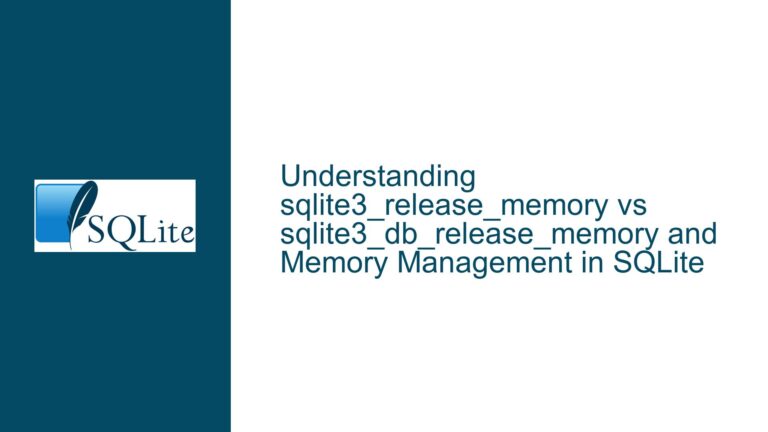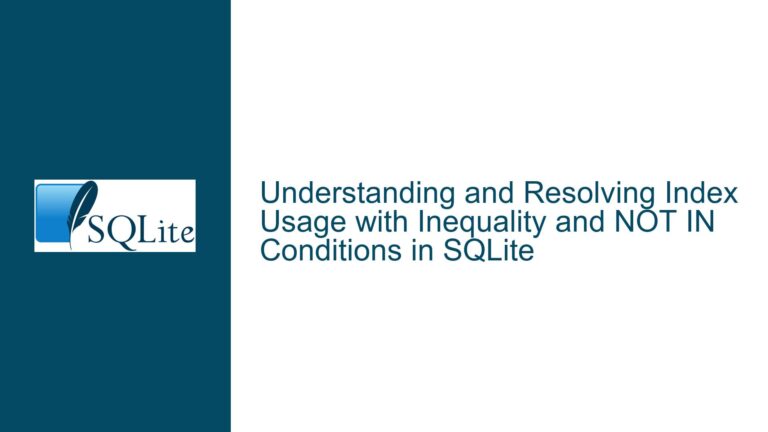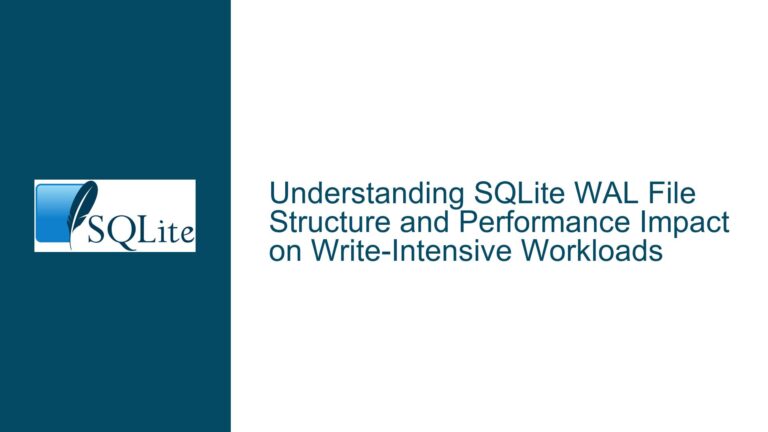Slow Join Performance Due to Implicit Column Type Mismatch in SQLite
Issue Overview: Join Query Execution Time Dwarfs Individual Filtered Queries
The core problem revolves around a significant performance disparity between two logically equivalent query approaches in SQLite. The first approach executes two separate queries filtering indexed columns, completing in under 0.002 seconds. The second approach combines these operations via an INNER JOIN but requires over 1 second to execute – a 500x slowdown. This occurs despite both tables containing appropriate indexes and the join condition appearing to leverage them.
Key observations from the execution environment:
- Parent table contains 1M rows with
parent_idPRIMARY KEY - Child table contains 10M rows (10 children per parent)
- Specialized partial index on parent (
parent_skewed) filtersskewed_id=1 - Standard index on child (
child_parent) coversparent_id - Query plans show proper index usage in isolation but full table scans during joins
The paradox emerges because individual indexed lookups work as expected when executed separately, but combining them through a join triggers suboptimal execution plans. This manifests specifically when joining on columns where one side lacks explicit type declarations, creating hidden type affinity mismatches that prevent index utilization during join operations.
Possible Causes: Implicit Typing Conflicts and Index Selection Failures
Three primary factors contribute to this performance anomaly:
Column Affinity Mismatch in Join Predicates
- Parent table declares
parent_idas INTEGER PRIMARY KEY - Initial child table declaration omits type for
parent_id(default NUMERIC affinity) - SQLite stores both as integers but treats them as different types during comparisons
- Indexes become unusable for join operations due to implicit type conversion requirements
- Parent table declares
Partial Index Scope Limitations
parent_skewedindex filters rows whereskewed_id=1- Join queries may bypass partial index optimizations when combining with other predicates
- Query planner struggles to combine partial index constraints with join conditions
Cost Estimation Errors in Join Order Selection
- Automatic query planner miscalculates join sequence costs
- Full table scan of child table appears cheaper than indexed lookup due to:
- Incorrect row count estimates from missing ANALYZE data
- Hidden type conversion costs not factored into plan selection
- Temporary storage requirements for unindexed joins increase I/O overhead
The critical issue stems from SQLite’s type affinity system. While both parent.parent_id and child.parent_id store integer values, the child’s column initially uses NUMERIC affinity (from unspecified type) versus the parent’s INTEGER affinity. This creates silent type mismatches that:
- Prevent index utilization on the child table during joins
- Force full table scans due to comparison type conversions
- Invalidate covering index optimizations
- Increase memory usage through temporary comparison buffers
Troubleshooting Steps, Solutions & Fixes: Resolving Type Conflicts and Optimizing Join Plans
Step 1: Enforce Column Type Consistency
Explicitly declare column types in all table definitions:
-- Original problematic definition
CREATE TABLE child (
child_id INTEGER PRIMARY KEY,
parent_id -- Type omitted, defaults to NUMERIC affinity
);
-- Corrected definition
CREATE TABLE child (
child_id INTEGER PRIMARY KEY,
parent_id INTEGER -- Explicit INTEGER affinity
);
This aligns type affinities between parent.parent_id (INTEGER) and child.parent_id (INTEGER), enabling proper index utilization during joins.
Verification method:
SELECT
typeof(p.parent_id) AS parent_type,
typeof(c.parent_id) AS child_type
FROM parent p
JOIN child c ON p.parent_id = c.parent_id
LIMIT 1;
Ensure both columns report ‘integer’ type.
Step 2: Analyze and Rebuild Indexes
After modifying table schemas:
- Drop and recreate affected indexes:
DROP INDEX child_parent;
CREATE INDEX child_parent ON child(parent_id);
- Refresh statistics:
ANALYZE;
- Verify index usage in query plans:
EXPLAIN QUERY PLAN
SELECT p.parent_id, c.child_id
FROM parent p
JOIN child c ON p.parent_id = c.parent_id
WHERE p.skewed_id = 1;
The optimal plan should show:
|--SEARCH p USING INDEX parent_skewed
`--SEARCH c USING INDEX child_parent
Step 3: Utilize Indexed Subqueries for Complex Predicates
When dealing with partial indexes, explicitly guide the planner using subqueries:
SELECT p.parent_id, c.child_id
FROM (SELECT parent_id FROM parent WHERE skewed_id = 1) p
JOIN (SELECT child_id, parent_id FROM child) c USING (parent_id);
This separation:
- Forces use of
parent_skewedpartial index first - Reduces join complexity by pre-filtering parents
- Enables batch optimization of child lookups
Step 4: Implement Manual Query Planner Hints
Override suboptimal plan choices with SQLite-specific extensions:
SELECT p.parent_id, c.child_id
FROM parent p INDEXED BY parent_skewed
JOIN child c INDEXED BY child_parent
ON p.parent_id = c.parent_id
WHERE p.skewed_id = 1;
Key considerations:
- Use
INDEXED BYsparingly – only after verifying better plans exist - Monitor performance across SQLite versions as planner improvements may obsolete hints
- Combine with
ORDEREDclause to enforce join sequence:
SELECT /*+ ORDERED */ p.parent_id, c.child_id
FROM parent p INDEXED BY parent_skewed
JOIN child c INDEXED BY child_parent ON p.parent_id = c.parent_id;
Step 5: Optimize Storage Layout for Join Patterns
For large datasets, co-locate related records using:
- Cluster child records with parents:
CREATE TABLE child (
child_id INTEGER PRIMARY KEY,
parent_id INTEGER REFERENCES parent,
CLUSTER KEY (parent_id)
) WITH (CLUSTERED = true);
Note: SQLite doesn’t natively support clustered indexes, but can emulate via:
- Rowid ordering optimization:
INSERT INTO child (parent_id)
SELECT parent_id FROM parent
ORDER BY parent_id; -- Physically order child rows by parent_id
This improves locality during full scans when indexes can’t be used.
Step 6: Utilize Covering Indexes for Common Projections
Create indexes that satisfy all query columns:
CREATE INDEX child_parent_covering ON child(parent_id, child_id);
Then verify usage with:
EXPLAIN QUERY PLAN
SELECT c.child_id FROM child c WHERE parent_id = 1234;
Output should show:
`--SEARCH c USING INDEX child_parent_covering
Step 7: Monitor and Adjust Type Conversion Rules
Explicitly cast join columns when schema changes aren’t possible:
SELECT p.parent_id, c.child_id
FROM parent p
JOIN child c ON p.parent_id = CAST(c.parent_id AS INTEGER)
WHERE p.skewed_id = 1;
Warning: This approach:
- Incurs per-row conversion costs
- May still prevent index usage
- Should be temporary until schema can be fixed
Step 8: Leverage Materialized Views for Frequent Joins
For read-heavy workloads, precompute joins:
CREATE TABLE parent_child_join AS
SELECT p.parent_id, c.child_id
FROM parent p
JOIN child c ON p.parent_id = c.parent_id
WHERE p.skewed_id = 1;
-- Refresh periodically
DELETE FROM parent_child_join;
INSERT INTO parent_child_join
SELECT p.parent_id, c.child_id FROM ...;
Maintenance strategies:
- Trigger-based updates (caution with write performance)
- Batch updates during off-peak hours
- Versioned materializations for historical data
Step 9: Configure Connection-Level Optimizations
Adjust SQLite PRAGMA settings for join-heavy workloads:
PRAGMA temp_store = MEMORY; -- Keep temps in RAM
PRAGMA cache_size = -10000; -- 10MB cache
PRAGMA mmap_size = 1073741824; -- 1GB memory mapping
PRAGMA threads = 4; -- Enable parallel processing where available
Note: Settings are connection-specific and must be reapplied on each database handle initialization.
Step 10: Profile and Analyze Low-Level I/O Patterns
Use SQLite’s VDBE (Virtual Database Engine) to inspect opcode execution:
EXPLAIN
SELECT p.parent_id, c.child_id
FROM parent p
JOIN child c ON p.parent_id = c.parent_id
WHERE p.skewed_id = 1;
Key areas to examine in the output:
- Number of
ColumnvsRowidops - Presence of
Affinityoperations OpenReadinstructions indicating table scansSeek/NotFoundcounts for index efficiency
Final Resolution Workflow
Schema Validation
- Confirm consistent INTEGER declarations on joined columns
- Verify index definitions include necessary columns
Query Plan Analysis
- Check for SCAN operations where SEARCH expected
- Identify type affinity conversions in WHERE/JOIN clauses
Performance Benchmarking
- Compare individual query times vs joined versions
- Measure index hit rates using
sqlite3_analyzer
Incremental Optimization
- Apply type fixes first
- Add covering indexes as needed
- Introduce query hints only when necessary
Long-Term Monitoring
- Log slow queries using
.eqp fulloutput - Regularly update statistics with ANALYZE
- Review schema after major data changes
- Log slow queries using
By systematically addressing type affinity mismatches, enforcing proper index usage, and guiding the query planner through schema design and SQL hints, developers can eliminate unexpected join performance regressions in SQLite. The critical insight lies in recognizing that even when stored values appear identical, SQLite’s type handling rules during comparisons can dramatically impact execution plans – a nuance that becomes particularly evident in join operations across large datasets.
